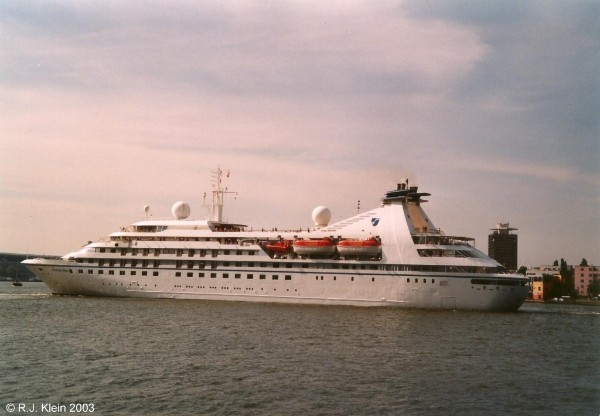|  |  |  |
Seabourn Pride In the middle of the 1980's, after a somewhat silent period in cruiseship newbuildings, more and more cruiselines started to order new tonnage for the booming market. In the 1970's, cruiselines mostly operated with rebuild oceanliners and freighters, but to attract new and more passengers something had to change. In 1984, Princess Cruises started the trend towards new and bigger cruiseliners with the Royal Princess, even as Carnival Cruise Lines with ships like Celebration and Holiday. A lot of lines followed and new cruiselines were starting up in rapid succession also. So there was a trend towards big ships evolving, but besides that, some other companies started to focus themselves on the luxury upmarket and one of the first to do so was the Norwegian company Sea Goddess Cruises with the small but ultraluxurious Sea Goddess 1 and Sea Goddess 2. These yaughtlike vessels started cruising in 1984. Two years later, a company named Signet Cruise Line was formed, also in Norway, by an investiment group led by Atle Brynestad. But because an American claimed the rights to the name Signet by way of a lawsuit, the company changed its name to Seabourn Cruise Line. In november 1988, their first ship Seabourn Pride was delivered. She was built at the Schichau Seebeckwerft in Western Germany. A small and luxurious cruiseliner, with a tonnage of 9.975. She is 134,10 meters long, 19,20 meters wide and her draft is 5,15 meters. She was built for 203 passenger and 150 crew, this ratio shows her status, as she was rewarded with 5 stars by Berlitz. On her positioning voyage to the United States for the start of her maiden cruise, she ran into an angry stormfront that slowed her down so bad that Seabourn had to cancell their first cruise. Of course, this small ship (although double the size of the Sea Goddess-yaughts) was built for soft-weather conditions in the sunny Caribbean and not for North Atlantic voyages. A second ship, Seabourn Spirit, was added to the new company's fleet in 1989 and a thirth exact sister was built in 1992, but she became part of Klosters' Royal Viking Line as Royal Viking Queen. In 1991, Carnival bought a 25 % stake in the company, and just a few years later Seabourn would be fully Carnival-owned but remained intact as a seperate brand. Some other changes in the cruiseworld would affect Seabourn later on, as Kloster sold their Royal Viking Line to Trafalgar House, the parent company of Cunard Line, in 1994. Royal Viking Line sailed only with Royal Viking Sun and Royal Viking Queen at that moment. Royal Viking Sun moved to Cunard and Royal Viking Queen was transferred to Klosters' Royal Cruise Line-brand and was renamed Queen Odyssey in the Royal Cruise Line naming tradition. This was only for a very short while. Kloster seemed to be not very good to manage more than one cruiseline, because Royal Cruise Line was also shut down in 1995. Two ships transferred to Norwegian Cruise Line, one was sold to Fred. Olsen as Black Watch and the small Queen Odyssey went to her sisters of Seabourn Cruise Line as Seabourn Legend. The three ships look exactly the same, and because of the growth of the company, the ships were seen everywhere around the world from the mid-1990's onwards. In 1997, Seabourn Legend collided with the huge tanker Eindhoven Lion when she was hijacked on a Caribbean cruise and she was nearly destroyed. Luckily, this was only in the movie 'Speed 2' by Dutch Jan de Bont, starring Sandra Bullock for extra viewing pleasure.  Another milestone for Seabourn Cruise Line came in 1998, when the company was merged with Cunard Line as Cunard Line Ltd. by parent company Carnival Corporation. This did not effect the name of the company or the ships, because Cunard and Seabourn kept trading as two different names. But Seabourn got a few things out of this deal, when Cunards Royal Viking Sun, Sea Goddess 1 and Sea Goddess 2 (yes, they became a part of Cunard in 1986) transferred to and doubled the capacity of Seabourn as Seabourn Sun, Seabourn Goddess 1 and Seabourn Goddess 2 respectively in 1999. It was clear the company was not really anxious to recieve this fleet-doubling, because all three ships left the Seabourn fleet just three years later. So, from 2002 onwards Seabourn was reduced to the three sisters of the beginning. Their ships still sail worldwide cruises and of these sisters, Seabourn Pride often shows herself in the port of Amsterdam. From march 2006, the Yaughts of Seabourn are managed by V-ships, the former owner of Sitmar Cruises, sold to P&O in 1988. At this moment, V-ships, based in Monaco, also manages Regent Seven Seas Cruises and Silversea Cruises. Recently, the first newbuilding for Seabourn since, well, the first ships were built, was launched. The Seabourn Odyssey joined the fleet in 2009 and she was followed by Seabourn Sojourn in june 2010. These new ships are based on the design of the first trio, but they are some 3 times bigger measuring 32.000 tons. Still, they only have room for 450 passengers. These ships will bring Seabourn back to the forefront of luxury cruising. |
 |
|  |  |
|  |
|

